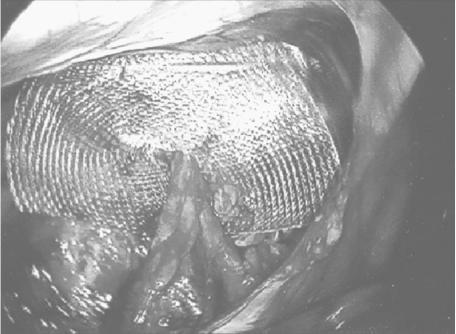BACKGROUND
Laparoscopic repair of inguinal hernias has been found to be associated with significantly lower incidences of wound infection, haematoma formation, nerve damage, chronic pain syndrome and an earlier return to normal activities when compared to open approaches such as the Lichtenstein repair, with no difference in overall morbidity. However, the recurrence rate has been shown to be higher.1,2 Mechanisms of recurrence may be related to technical difficulties and the use of inadequate mesh size and positioning. We describe a composite mesh technique for consideration in the repair of large defects.
TECHNIQUE
A standard laparoscopic approach is used as for TAPP inguinal hernia repair. A first piece of 11 cm × 6 cm polypropylene mesh is shaped and positioned over the posterior wall, wrapped around the cord laterally (Fig. 1). A second main 15 cm × 10 cm mesh is then shaped and positioned medially over the first and stapled to the pubic tubercle and superior-medially before being covered by the peritoneum.
Figure 1.
Primary subsidiary mesh covering defect.
We used this composite mesh repair technique in 45 consecutive patients (54.6 ± 13.1 years), 12 cases of unilateral recurrence and 33 bilateral hernias, a total of 78 hernia repairs in all. The mean follow-up period was 23.7 ± 16.7 months. There were only three minor complications – two groin and one port-site haematomas, all of which resolved conservatively. No recurrences or ilio-inguinal neuropathies were observed. LOS 1.2 ± 0.4 days.
DISCUSSION
The TAPP composite mesh technique for inguinal hernia repair described here is a safe procedure with a zero recurrence rate at 2 years in this small series. Similar to findings from extraperitoneal composite mesh technique series.3,4 It is relatively easy to perform and negates the problems of poor mesh positioning and inadequate mesh size.
References
- 1.Schmedt CG, Sauerland S, Bittner R. Comparison of endoscopic procedures vs Lichtenstein and other open mesh techniques for inguinal hernia repair. Surg Endosc. 2005;19:188–99. doi: 10.1007/s00464-004-9126-0. [DOI] [PubMed] [Google Scholar]
- 2.McCormack K, Wake B, Perez J, Fraser C, Cook J, McIntosh E, et al. Laparoscopic surgery for inguinal hernia repair: systematic review of effectiveness and economic evaluation. Health Technol Assess. 2005;9:1–203. doi: 10.3310/hta9140. [DOI] [PubMed] [Google Scholar]
- 3.Posta CG. Laparoscopic inguinal hernia repair with extraperitoneal double mesh technique. J Laparoendosc Adv Surg Tech A. 1997;7:19–27. doi: 10.1089/lap.1997.7.19. [DOI] [PubMed] [Google Scholar]
- 4.Halkic N, Ksontini R, Corpataux JM, Bekavac-Beslin M. Laparoscopic inguinal hernia repair with extraperitoneal double mesh technique. J Laparoendosc Adv Surg Tech A. 1999;9:491–4. doi: 10.1089/lap.1999.9.491. [DOI] [PubMed] [Google Scholar]



